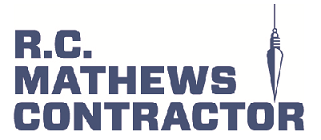Title Page
-
Conducted on
-
Prepared by
R.C. Mathews Contractor, LLC
-
Jobsite / Project #:
-
Inspection Date:
-
Superintendent(s):
-
Safety Manager:
Project Inspection Overview
General:
-
OSHA 300 Forms / Labor Department Posters Posted:
-
OSHA Poster Location(s):
-
Medical Clinic / Emergency Numbers Posted:
-
New Hire Orientation:
-
Safety Meetings (Tool Box Talks / Stand Downs):
-
Project Specific Safety Meetings:
-
Near Misses / Incidents:
-
Daily Reports / Job Safety Analysis Completed:
-
Emergency Action Plan in Place:
-
First Aid Kits / Trained RCMC Employees:
-
Location of First Aid Kit(s):
-
Sanitation / Hand Washing / Toilets:
-
SWPPP:
-
Perimeter Fencing & RCMC Signage in Place:
Structure Entrance:
-
Overhead Protection in Place at Entrances:
-
Drop-zone Area Established (overhead work):
Personal Protective Equipment (PPE):
-
Hard Hats:
-
Eye / Face Protection:
-
Hearing Protection:
-
Respiratory Protection:
-
Foot Protection / Footwear:
-
Proper Work Clothing:
-
Hand Protection:
-
Personal Fall Arrest Systems:
-
PPE Overview:
Housekeeping:
-
Walkways / Stairs / Access & Egress:
-
Staging / Storage Areas:
-
Materials / Trash Removal:
-
Nails Bent or Removed:
-
Housekeeping Overview:
Fire Protection / Prevention:
-
Fire Extinguishers:
-
Flammable Materials Storage:
-
Flammable Liquids Stored in Approved Containers:
-
Fuel Tanks Stored at a Minimum of 20' from Structures with Fire Extinguishers in place within 50':
-
Welding / Cutting Operations:
-
Fire Watch:
-
Fire Protection / Prevention Overview:
Hand & Power Tools:
-
Tool Condition:
-
Guarded / Power Cords:
-
Proper Usage:
-
Pneumatic Tools Inspected and Connections Secured:
-
Air Hoses & Whip Checks:
-
Power Actuated Tools Inspected and Operators Trained:
-
Hand & Power Tools Overview:
Stairways / Ladders:
-
Ladder Condition / Use:
-
Stairway / Ladder / Ramp used where 19" Break in Elevation Exists:
-
Ladders Secured (Top & Bottom):
-
Ladders Extended 3' above landing:
-
36" clearance of Materials around base of Ladder
-
Proper Working Angle (4:1):
-
Cleats / Base Pad in Safe Working Condition:
-
Rungs & Rails in Safe Working Condition:
-
Labels Visible & Legible:
-
Ladder Overview:
Fall Protection:
-
Fall Arrest Systems Inspected Daily & Before Use:
-
Fall Protection Utilized when Exposed to Lower Level Falls (Greater than 6'):
-
Guardrails (Wood / Cable):
-
Warning Line Systems:
-
Safety Nets:
-
Horizontal Lifeline:
-
Holes (Greater than 2") / Wall Openings Covered and Identified:
-
Fall Protection Overview:
Scaffolding:
-
Daily & Monthly Inspections Completed:
-
Scaffolding Erected on Solid, Level Footing:
-
Braced / Secured to Structure:
-
Planks & Platforms:
-
Access & Egress in Place:
-
Top / Mid / Toe-board in Place and Secured:
-
Scaffolding Overview:
Aerial / Boom Lifts:
-
Scissor Lifts Inspected Before Use:
-
Chain / Access Secured while Operating Scissor Lift:
-
Aerial / Boom Lifts Inspected Before Use:
-
Fall Protection Utilized while Operating Aerial / Boom Lifts:
-
Proper Usage:
-
Proper Anchorage Points Used:
-
Personnel Trained for Lift Operations:
-
Aerial / Boom Lift Overview:
Electrical:
-
Lighting / Covers:
-
Grounding:
-
Extension Cords, Plugs, Receptacles:
-
Temporary Power / Lighting / Portable Boxes:
-
GFCI's in Place:
-
Wires Marked & Identified:
-
Warning & Danger Signs in Place:
-
Electrical Overview:
Trenching & Excavation:
-
Competent Person(s) Identified:
-
Daily Inspections Completed / if Conditions Change:
-
Underground Utilities Marked and Identified:
-
Soil Classification Identified (Type A, B or C):
-
Spoils Placed 2' back or more:
-
Means of Access / Egress within 25':
-
Benching - Type B (1:1) / Sloping - Type C (1.5:1):
-
Trench Box / Shielding Used (Greater than 5'):
-
Tabulated Data Onsite and Documented with Trench Box:
-
Fall Protection / Barricades in place and Adequate:
-
Equipment Positioned / Moved away from Trench or Excavation Edge:
-
Trenching & Excavation Overview:
Cranes:
-
Rigging (slings, chains, hooks and shackles) Inspected and in Good Working Condition:
-
Crane Positioned on Firm / Level Surface:
-
Outriggers / Proper Cribbing used Properly:
-
Swing Radius Marked and Identified:
-
Load Chart Posted in Cab:
-
10' of Power-line Clearance up to (50kv) / 20' of Power-line Clearance if Voltage is Unknown:
-
Crane Operators Trained / Certification Cards up-to-date:
Miscellaneous:
Comments:
Observations:
-
Add media
-
Add media
-
Add media
-
Add media
-
Add media
-
Add signature














